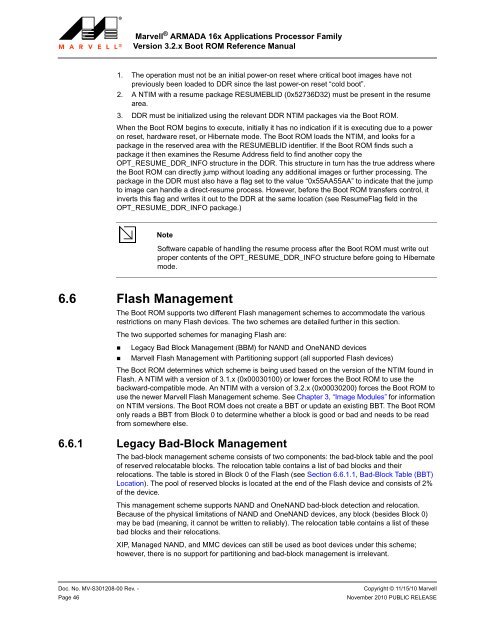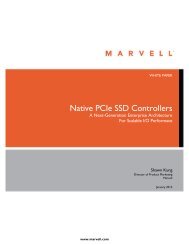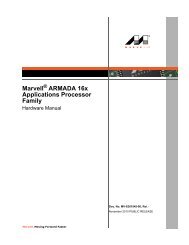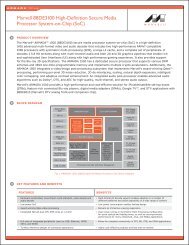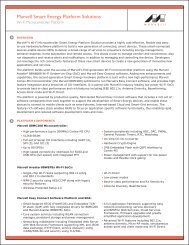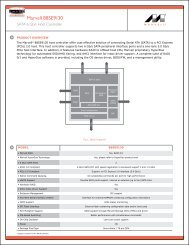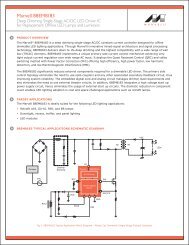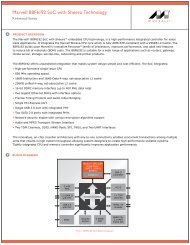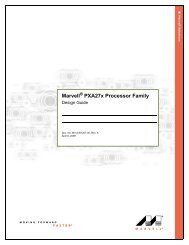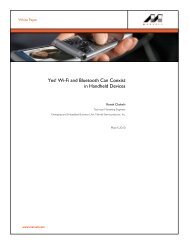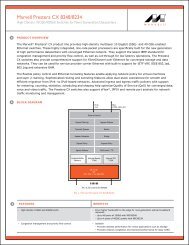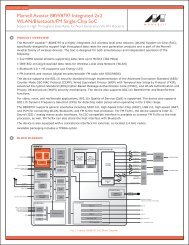Marvell ARMADA 16x Applications Processor Family
7 Marvell ® ARMADA 16x Applications Processor Family ...
7 Marvell ® ARMADA 16x Applications Processor Family ...
- No tags were found...
You also want an ePaper? Increase the reach of your titles
YUMPU automatically turns print PDFs into web optimized ePapers that Google loves.
<strong>Marvell</strong> ® <strong>ARMADA</strong> <strong>16x</strong> <strong>Applications</strong> <strong>Processor</strong> <strong>Family</strong><br />
Version 3.2.x Boot ROM Reference Manual<br />
1. The operation must not be an initial power-on reset where critical boot images have not<br />
previously been loaded to DDR since the last power-on reset “cold boot”.<br />
2. A NTIM with a resume package RESUMEBLID (0x52736D32) must be present in the resume<br />
area.<br />
3. DDR must be initialized using the relevant DDR NTIM packages via the Boot ROM.<br />
When the Boot ROM begins to execute, initially it has no indication if it is executing due to a power<br />
on reset, hardware reset, or Hibernate mode. The Boot ROM loads the NTIM, and looks for a<br />
package in the reserved area with the RESUMEBLID identifier. If the Boot ROM finds such a<br />
package it then examines the Resume Address field to find another copy the<br />
OPT_RESUME_DDR_INFO structure in the DDR. This structure in turn has the true address where<br />
the Boot ROM can directly jump without loading any additional images or further processing. The<br />
package in the DDR must also have a flag set to the value “0x55AA55AA” to indicate that the jump<br />
to image can handle a direct-resume process. However, before the Boot ROM transfers control, it<br />
inverts this flag and writes it out to the DDR at the same location (see ResumeFlag field in the<br />
OPT_RESUME_DDR_INFO package.)<br />
Note<br />
Note<br />
6.6 Flash Management<br />
Software capable of handling the resume process after the Boot ROM must write out<br />
proper contents of the OPT_RESUME_DDR_INFO structure before going to Hibernate<br />
mode.<br />
The Boot ROM supports two different Flash management schemes to accommodate the various<br />
restrictions on many Flash devices. The two schemes are detailed further in this section.<br />
The two supported schemes for managing Flash are:<br />
• Legacy Bad Block Management (BBM) for NAND and OneNAND devices<br />
• <strong>Marvell</strong> Flash Management with Partitioning support (all supported Flash devices)<br />
The Boot ROM determines which scheme is being used based on the version of the NTIM found in<br />
Flash. A NTIM with a version of 3.1.x (0x00030100) or lower forces the Boot ROM to use the<br />
backward-compatible mode. An NTIM with a version of 3.2.x (0x00030200) forces the Boot ROM to<br />
use the newer <strong>Marvell</strong> Flash Management scheme. See Chapter 3, “Image Modules” for information<br />
on NTIM versions. The Boot ROM does not create a BBT or update an existing BBT. The Boot ROM<br />
only reads a BBT from Block 0 to determine whether a block is good or bad and needs to be read<br />
from somewhere else.<br />
6.6.1 Legacy Bad-Block Management<br />
The bad-block management scheme consists of two components: the bad-block table and the pool<br />
of reserved relocatable blocks. The relocation table contains a list of bad blocks and their<br />
relocations. The table is stored in Block 0 of the Flash (see Section 6.6.1.1, Bad-Block Table (BBT)<br />
Location). The pool of reserved blocks is located at the end of the Flash device and consists of 2%<br />
of the device.<br />
This management scheme supports NAND and OneNAND bad-block detection and relocation.<br />
Because of the physical limitations of NAND and OneNAND devices, any block (besides Block 0)<br />
may be bad (meaning, it cannot be written to reliably). The relocation table contains a list of these<br />
bad blocks and their relocations.<br />
XIP, Managed NAND, and MMC devices can still be used as boot devices under this scheme;<br />
however, there is no support for partitioning and bad-block management is irrelevant.<br />
1<br />
2<br />
3<br />
4<br />
5<br />
6<br />
7<br />
8<br />
9<br />
10<br />
11<br />
12<br />
13<br />
14<br />
15<br />
16<br />
17<br />
18<br />
19<br />
20<br />
21<br />
22<br />
23<br />
24<br />
25<br />
26<br />
27<br />
28<br />
29<br />
30<br />
31<br />
32<br />
33<br />
34<br />
35<br />
36<br />
37<br />
38<br />
39<br />
40<br />
41<br />
42<br />
43<br />
44<br />
45<br />
46<br />
47<br />
48<br />
49<br />
50<br />
51<br />
52<br />
53<br />
54<br />
55<br />
56<br />
57<br />
58<br />
Doc. No. MV-S301208-00 Rev. - Copyright © 11/15/10 <strong>Marvell</strong><br />
Page 46<br />
November 2010 PUBLIC RELEASE


